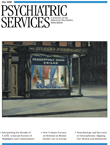Datapoints: Did CATIE Influence Antipsychotic Use?
The Clinical Antipsychotic Trials of Intervention Effectiveness (CATIE) provided evidence in September 2005 that for patients diagnosed as having schizophrenia, the first-generation antipsychotic perphenazine was no different in overall effectiveness when compared pair-wise with olanzapine, risperidone, quetiapine, and ziprasidone ( 1 ). The study also provided evidence in April 2006 that clozapine had substantial advantages for patients who demonstrated inadequate antipsychotic response to their initial randomized second-generation antipsychotic ( 2 ). Our study aimed to determine whether CATIE had any impact on prescribing for patients hospitalized within the psychiatric centers operated by the New York State Office of Mental Health.
Using the Integrated Research Database ( 3 ), we examined data from January 2005 through March 2007 for patients with a diagnosis of schizophrenia (N=2,210 for the first quarter of 2005 and N=2,102 for the first quarter of 2007).
Figure 1 describes the percentage of patients receiving prescriptions for the medications tested in CATIE ( 1 , 2 ) as well as for haloperidol. The use of perphenazine increased from a low of 1.2% in 2005 to a high of 2.6% one year later. Clozapine use increased from 20.6% of patients in 2005 to 24.9% two years later. Relative to the first quarter of 2005, the increases in perphenazine use were significant starting with the second quarter of 2006. The increases for clozapine were significant starting in the third quarter of 2006.

The observed changes in perphenazine and clozapine use corresponded with the publication of the CATIE results ( 1 , 2 ). The temporal relationship between the publication of CATIE and the small absolute increase in use of those specific medicines whose effectiveness was highlighted by the trial suggests that CATIE's findings may not have fallen entirely on deaf ears.
Acknowledgments and disclosures
Dr. Citrome is a consultant for, has received honoraria from, or has conducted clinical research supported by Abbott Laboratories, AstraZeneca Pharmaceuticals, Avanir Pharmaceuticals, Azur Pharma, Barr Laboratories, Bristol-Myers Squibb, Eli Lilly and Company, Forest Research Institute, GlaxoSmithKline, Janssen Pharmaceuticals, Jazz Pharmaceuticals, Pfizer, and Vanda Pharmaceuticals. The other authors report no competing interests.
1. Lieberman JA, Stroup TS, McEvoy JP, et al: Effectiveness of antipsychotic drugs in patients with chronic schizophrenia. New England Journal of Medicine 353:1209–1223, 2005Google Scholar
2. McEvoy JP, Lieberman JA, Stroup TS, et al: Effectiveness of clozapine versus olanzapine, quetiapine, and risperidone in patients with chronic schizophrenia who did not respond to prior atypical antipsychotic treatment. American Journal of Psychiatry 163:600–610, 2006Google Scholar
3. Citrome L, Jaffe A, Levine J: Dosing of second-generation antipsychotic medication in a state hospital system. Journal of Clinical Psychopharmacology 25:388–391, 2005Google Scholar



